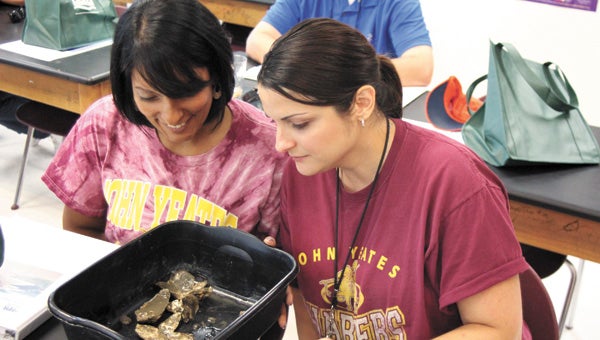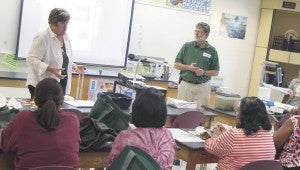River of learning
Published 11:10 pm Thursday, August 22, 2013

John Yeates Middle School teachers Sarah McDonald and Mary Francisci inspect a tub of oysters while hearing from the Nansemond River Preservation Alliance about science lessons the group has developed for seventh-graders.
Like many other rich and beautiful ecosystems, the Nansemond River watershed is often dubbed nature’s classroom.
Its wetlands and tributaries and flora and fauna are replete with opportunities to learn about the workings of the natural environment.
Elizabeth Taraski, executive director of the Nansemond River Preservation Alliance, says that’s the main reason the group has developed curriculum for science teachers in Suffolk’s public middle schools based on the watershed.
“It’s about connecting classrooms with our environment,” Taraski said during a presentation on Thursday. “They are localized lessons to give an understanding of the Nansemond River watershed.”

At King’s Fork High School on Thursday, Karla Smith and John Hass, volunteers with the local environmental group, demonstrate the middle school science curriculum developed for seventh-graders by the Nansemond River Preservation Alliance.
The alliance developed and will help deliver six hands-on lessons, with funding from the Hampton Roads Community Foundation, the Suffolk Foundation, the Community Action Coalition of Virginia and its own individual and corporate members.
Lessons include an overview of Suffolk’s waterways and their history, water quality and data collection, local watersheds and oyster reefs and the environmental impact of human activity.
Alliance volunteers, including Karla Smith and John Wass, developed the Standards of Learning-matched lessons with Catherine Roberts, who is an instructional coach with the Virginia Initiative for Science Teaching and Achievement and a former middle school science teacher.
Teachers will be armed with detailed lesson plans augmented with maps and informative DVDs and CDs.
Next month, 11 science educators will begin teaching the curriculum for the first time in Suffolk’s public middle schools, reaching 1,100 seventh-graders Taraski calls “our next generation of environmental leaders.”
During a preservice session at King’s Fork High School Thursday, Smith told teachers lessons would promote public access of waterways and environmental stewardship, as well as reinforce skills in critical subjects like science, technology, engineering and math.
Naturally, oysters are front and center in lessons, and a field trip on the Nansemond to “plant” the mollusks as part of the alliance’s oyster gardening efforts will be included in the program, Taraski said.
“Those not able to do that will have another opportunity at River and Creek Fest,” she said. “Through our volunteers, we are bringing the oysters into the classroom, so they can have that experience.”
Students will learn about other organisms living alongside oysters, such as sea lettuce and skilletfish, and take pre- and post-lesson tests to chart their level of understanding.
Catherine Walsh, its supervisor for K-12 science instruction, said the school district appreciates a partnership that will bring more inquiry-based learning into classrooms.
The alliance delivered some elements of the lessons to students last year, Taraski said.
“With the enthusiasm of the students, it’s very rewarding to see them enjoying learning,” she added.
Seventh grade was selected, because students are beginning to learn life sciences, Taraski explained. “It complements and enhances their current learning experience,” she added.





